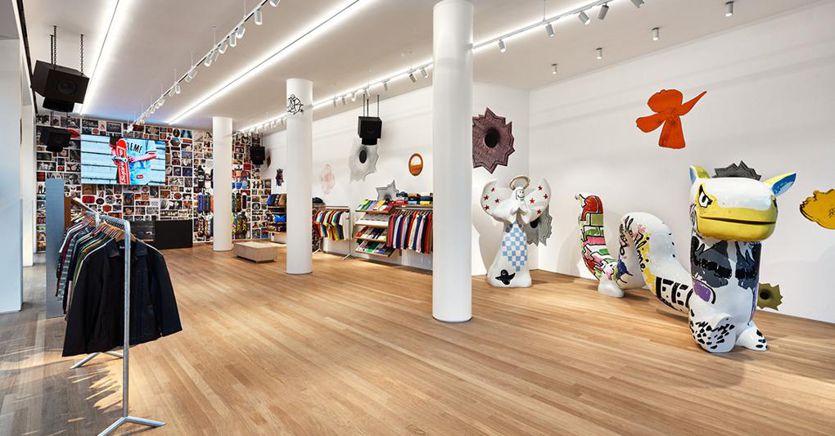There was a time, not far away but which seems very far away, when New York fashion week seemed to want to compete for leadership with European ones and in particular in Milan and Paris. An objective of the tsarina (the definition is not accidental) of American fashion, Anna Wintour, director of Vogue since 1988, global chief content officer of Condé Nast since 2020, never achieved: not only is the editorial group to which many of them head in crisis magazines, as well as Vogue. So are New York fashion week and the local Chamber of Fashion, chaired by a reluctant Tom Ford, who according to some is about to sell his brand to the giant Esteé Lauder and is now more at home in California than in New York. American fashion brands don’t look great either, except for the historical names of Ralph Lauren and, secondly, Tommy Hilfiger and Calvin Klein. The designers of the following generations, who should have or could have picked up the baton of the big names, pushed by Anna Wintour, never really made the big leap, except perhaps Marc Jacobs. Anna Sui, Zac Posen and even Narciso Rodriguez – whose income comes overwhelmingly from perfumes, not clothing and accessories – have never made the leap from talented young people to global designers.
The growing success of casual
But there is a fashion sector, whose birth is due precisely to the United States, which knows no crisis and which is in fact a leader in the world, as shown by the half-yearly reports of listed companies. At the beginning it was casualwear, then it became sportswear and finally streetwear, not surprisingly all American words. But the scope – always snubbed by Anna Wintour – is the same: clothing and accessories increasingly distant from the idea of formal masculine and feminine pret-à-porter, increasingly unisex and increasingly inspiring for real fashion brands and their own, from Armani to Zegna, from Gucci to Prada, passing through Dolce & Gabbana and without forgetting the French fashion houses. They are successful and dictate trends first because they interpret the spirit of the time: dressing comfortably by combining characteristics of various worlds and in particular those that have always been dear to the younger generations, music and sport. But they also work because they seem much better off on the path of social and environmental sustainability, which will be the real discriminating factor for consumers of the future, starting from generation X (those born between 1997 and the first decade of the 2000s). Assuming that in reality it is not already for those of today, if we think not of the niche of high net worth individuals (liquid assets of over one million euros or dollars), but to the much larger mid-range market, the fast fashion giants and digital platforms, which have stopped running in double digits, but not growing. Even if distribution is one of the challenges to be overcome: the post-Covid rebound of retail is linked to its transformation, each store must become an experience that is not necessarily linked to the purchase.
The Italy of accessible luxury
Let’s start with Italy: Geox closed the first six months of the year with a turnover of 340.6 million, an increase of + 29% and an acceleration in the second quarter, which with a turnover of approximately 156 million (+ 35% on the second quarter of 2021 and + 13% on that of 2019) is the second best quarter in the history of Geox. The January-June period of the Aeffe group (Alberta Ferretti, Philosophy by Lorenzo Serafini, Moschino and Pollini brands), positioned in the medium-high range, closed with revenues of 176.5 million euros (+ 13.9% on the 2021). Piquadro, whose fiscal year begins on 1 April, provided the data for the April-June quarter: the Bolognese leather goods group (Piquadro, The Bridge and Lancel brands), closed with a turnover of 32 million, up 47 , 2% compared to the same period of FY 21-22, when it closed at 21.8 million and the flagship brand, Piquadro, in the first quarter grew by 36.4% to 11.8 million, also thanks to a strategy of attention to the sustainability of materials and processes and to the formula that combines design and functionality.
The jewelery sector is also doing well, where there are very few listed on Piazza Affari: Gismondi 1754 and Fope stand out. The first closed the first half at 7 million, with a growth of 79.8% over 2021, the second with consolidated net revenues of 27.7 million, 13 million more than in the period January-June 2021, equal to + 89.2%. A particularly significant figure when compared with the first half of 2019, compared to which growth was 78.1%. Among the global giants of accessible jewelery, the Danish Pandora stands out: the results of the first half will be announced on Tuesday 16 August, but in the first quarter the turnover had risen to 5.69 billion crowns (764 million euros), equal to +21 % on 2021 and + 18% compared to the pre-pandemic levels of 2019, above analysts’ expectations and with Italy and the United Kingdom at +30 percent.
The giants of sport
Also thanks to “hybridizations” with fashion, brands such as Puma (part of the French Kering group), which invested in collections suitable for everyday life, alongside the more technical ones and for professional sportsmen, closed the semester strongly growth: revenues increased by 53.7%. Less well the giants and eternal rivals Adidas and Nike, exposed on the Russian market, where sales have collapsed. The turnover of the first half of the first rose “only” by 5%, the fiscal year of the American group, whose data dates back to last June 27, saw a decline of 1%. But the prospects in the medium and long term remain positive, thanks to Generation X, partnerships with fashion and investments in social and environmental sustainability (in the photo above, the Supreme store in Milan, in Corso Garibaldi. The streetwear brand is part of the American group Vf).
